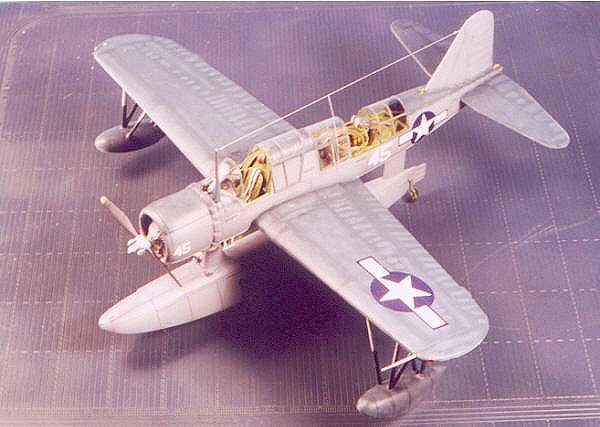
|
KIT # |
|
|
PRICE: |
$12.00 |
|
DECALS: |
Two aircraft |
|
REVIEWER: |
|
|
NOTES: |
AFTERMARKET: |
TURNING A CLOTH COAT INTO A MINK STOLE
|
HISTORY |

The Vought-Sikorsky OS2U "Kingfisher" was the first modern aircraft design by Chief Designer Rex B. Beisel, and pioneered the technique of spot-welding to create a non-buckling fuselage structure that would make the subsequent F4U Corsair so legendarily strong. It was also one of the first production aircraft to utilize full-span flaps and spoiler lateral control.
As the first U.S. Navy scout-observation two-seater to incorporate a monoplane wing design, the OS2U was designed in response to a 1937 request for proposals from the Bureau of Aeronautics. The XOS2U-1 first flew March 1, 1938, powered by a Pratt & Whitney R-985-4, rated at 450 h.p. The first production OS2U-1 flew two years later, while the first Kingfisher to join the U.S. Fleet was attached to U.S.S. "Colorado" (BB-45) on August 16, 1940, as a detachment of VO-4. 54 OS2U-1s were delivered by December 1940, followed quickly by 158 OS2U-2s, powered by a later R-985-50. Deliveries of the OS2U-3 - the most-produced version - began in May 1941. This sub-type had more fuel capacity and armor protection for the crew than its predecessors, and 1,006 were produced; 300 additional Kingfishers - designated OS2N-1 - were built by the Naval Aircraft Factory. There is evidence an additional 31 airframes were assembled from spare parts by the NAF.
Kingfisher crews lived a completely-different life than other Naval Aviators who were part of a full squadron based aboard a carrier. The fleet re-organization shortly after Pearl Harbor ended the administrative control of fleet scouting units by observation squadrons; the pilots, crews and maintenance technicians becoming part of the ship's company. They were then subject to the vagaries of the particular commanding officer, many of whom had never accepted aircraft and aviators as a legitimate part of the Navy. Resupply depended on a good relationship with the ship's supply officer, and a talent for "midnight requisitions" when in port.
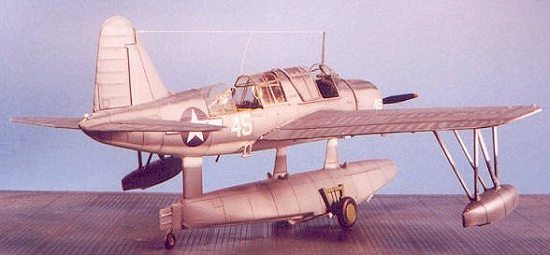 The Kingfishers
assigned to cruisers and battleships provided much-needed service in the early
days of the war, when they provided much of the air defense of early convoys;
Kingfishers did destroy at least two German U-boats and a Japanese I-boat during
this period. Additionally, they performed the traditional role of "eyes for the
fleet" during shore bombardment missions.
The Kingfishers
assigned to cruisers and battleships provided much-needed service in the early
days of the war, when they provided much of the air defense of early convoys;
Kingfishers did destroy at least two German U-boats and a Japanese I-boat during
this period. Additionally, they performed the traditional role of "eyes for the
fleet" during shore bombardment missions.
The Kingfisher's most important role during the war was as rescuer of downed aviators, and was second only to the PBY Catalina in this job. On November 11, 1942, a Kingfisher known as "The Bug" - which had survived the attack on Pearl Harbor - rescued Captain Eddie Rickenbacker and the crew of the B-17 he was with after they crashed in the Pacific and survived 28 days in life rafts. After rescuing pilot CAPT. W.T. Cherry and four others on November 11, "the Bug" found Rickenbacker's raft the next day. Unable to fly all three survivors back at one go, LT. William F. Eadie, the pilot, taxied the airplane 40 miles through the open sea with Rickenbacker and one crewman lashed to the wings, while the most seriously-ill survivor was stuffed in the rear seat on the lap of ARM1 L.H. Boutte, the crewman. "The Bug" survived this mission and continued to fly throughout the war.
One of the most dramatic Kingfisher rescue missions of the entire war was flown during the second Truk strike in April, 1944, by Lt.(j.g.) John A. Burns with rear gunner ARM1 Aubrey J. Gill, from the battleship U.S.S. "North Carolina." One of two OS2U-3s launched by the battleship, Burns first had to rescue his fellow aviator Lt.(j.g.)J.J. Dowdie and his gunner, R.E. Hill, after they landed in Truck Lagoon to pick up VF-6 pilot Lt.(j.g.) Bob Kanze. As Kanze grabbed the wingfloat of the first Kingfisher, he raft was swept away and - with Kanze's weight on the float - the Kingfisher capsized, throwing all three aviators into the water. Alighting successfully, Burns and Gill brought the three aboard, with Kanze on one wing, Dowdie on the other, and Hill hanging onto the fuselage. Unable to take off, Burns taxied to the U.S.S. "Tang," who picked up the three survivors.
Burns then took off and was directed to LT Robert Barbor from the U.S.S. "Langley." With Barbor aboard, Burns could not take off in the choppy sea. As they waited for the "Tang" to arrive, two TBM Avengers ditched nearby. Burns taxied to their position, where he attempted to take the two rafts with six aviators in tow; this proved impossible, since as soon as Burns increased power, backwash and spray soaked the six men and swamped the rafts. All six were then transferred to the Kingfisher, some on the wings and some on the fuselage to balance the load. As Burns began taxiing toward the "Tang," the submarine submerged to answer another emergency call. After rescuing another pilot, the "Tang" returned. By this time, the Kingfisher was taking on water in the main float and was listing badly due to the battering it was receiving as Burns worked to keep her off the nearby reef. All nine aviators were rescued by the "Tang," but the submarine was forced to sink the plucky little Kingfisher that had rescued ten aviators.
On February 16, 1945- - three days before the landings on Iwo Jima - an OS2U-3 flown from the U.S.S. "Pensacola" by Lt.(j.g.) D.W. Gandy was spotting for the naval bombardment of the island when he was attacked by an A6M-5 Zero-sen. Gandy managed to get on the tail of the enemy fighter after it fired at him, and opened fire with his single forward-firing .30-caliber machine gun. The Zero smoked, then burst into flames and crashed halfway up Mt. Suribachi.
The Kingfisher, which had been aboard the U.S.S. "Arizona" at the attack on Pearl Harbor, was also aboard the U.S.S. "Missouri" for the Japanese surrender in 1945. By 1947, the last one had disappeared from Navy service.
|
THE KIT |
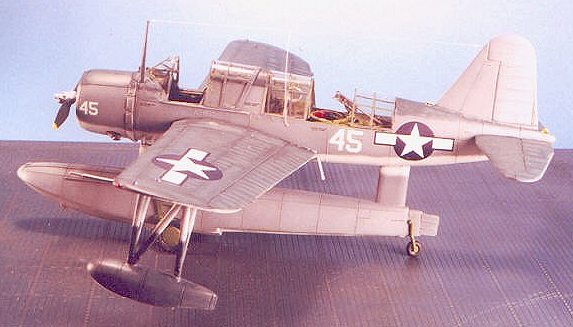 The Monogram
Kingfisher first appeared in the Spring of 1967. It was a transitional kit
between the more toylike early kits with their folding wings and retractable
landing gears, and the more accurate kits that began to appear around the same
time. The kit, which is very accurate for its time, has been re-released over
the years ever since, and is still the best Kingfisher model available in any
scale. The cockpit is better detailed than what existed before, but is little
more than an impression of the reality.
The Monogram
Kingfisher first appeared in the Spring of 1967. It was a transitional kit
between the more toylike early kits with their folding wings and retractable
landing gears, and the more accurate kits that began to appear around the same
time. The kit, which is very accurate for its time, has been re-released over
the years ever since, and is still the best Kingfisher model available in any
scale. The cockpit is better detailed than what existed before, but is little
more than an impression of the reality.
Back in the Sixties, the molding technology was such that only a certain percentage of the mold surface could be engraved for the parts. The result of this was kits like the Helldiver, which had wings of incorrect chord. Because Monogram molded the fuselage halves with the main float halves for the Kingfisher, this same problem resulted in a main float that is 35 percent too small. At the same time, the outboard floats are not accurate in outline.
In 2001, Cutting Edge released a series of correction sets for the Kingfisher - two very well-detailed cockpits in one, a correct-sized main float and correct-shaped outboard floats in the next, and finally a correct-sized and shaped engine cowl. All this comes to close to $50 retail, for a $12 kit! If you add in a Squadron (Falcon) vacuformed canopy so you can open things up and see all the beautiful interior detail, you have hit $50 in aftermarket parts. Is it worth it? Follow along:
|
CONSTRUCTION |
The first thing to do is cut off the old main float from the fuselage, cut off the engine cowling, and remove the locating pins inside the fuselage for the old cockpit parts. Once that was done, I sanded the new resin cockpit tubs to fit inside the fuselage, then assembled the cockpits and painted them per the instructions Cutting Edge provides. Once these are painted, it is immediately apparent that the resulting model is going to look about as good as an Accurate Miniatures SBD "Dauntless".
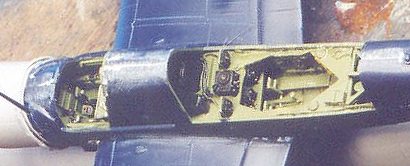 The next thing to do is
fit the rear cockpit in the fuselage, then slide the lower wing through the
opening and score it at the point of joining the fuselage. The center section
of the wings needs to be cut out, then the resin connector parts need to be
installed in the wings before they are finally assembled. Test fit, test fit
and test fit again before finally gluing, because if you screw this up, nothing
will fit.
The next thing to do is
fit the rear cockpit in the fuselage, then slide the lower wing through the
opening and score it at the point of joining the fuselage. The center section
of the wings needs to be cut out, then the resin connector parts need to be
installed in the wings before they are finally assembled. Test fit, test fit
and test fit again before finally gluing, because if you screw this up, nothing
will fit.
I then glued the cockpits
in position and glued the fuselage halves together. The wings were positioned,
the connectors were glued together with cyanoacrylate, and the wings were glued
to the fuselage 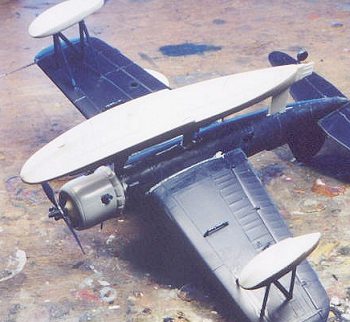 with Tenax.
I then attached the horizontal stabilizers and set this aside.
with Tenax.
I then attached the horizontal stabilizers and set this aside.
I didn't have an R-985 engine to fit in the cowl, but I took a resin R-1830 left over from the CA Hudson kit, and modified it to fit. Once in place, it looked right, and only an "engine rivet counter" will notice it's "wrong." I painted the engine and the interior of the cowling, glued the engine in position and then glued the cowling in position on the fuselage.
While all that was setting up, I turned to the floats. Resin molding blocks have to be removed from these - otherwise they are beautifully molded with no pinholes, so I assembled the various struts and set them aside.
After the airframe was cleaned up, using Mr. Surfacer on all the seams, I glued the central float in position, then attached the outboard floats to check alignment. I then removed the starboard float, since if it was in position it would be impossible to place the lower wing national insignia in the proper position.
As you can see from the photos, the model was starting to look good. It was time to head for the paint shop.
|
PAINT & DECALS |
Painting:
I did my Kingfisher in the tri-color scheme, after painting the entire model light grey so that painting would start on a neutral color. I preshaded, then painted the camouflage patterns on the basis of photographs of Kingfishers in that scheme. I faded the upper colors, using light grey, to simulate the sun-fading the airplane would have been subject to sitting on its catapult aboard ship in the Central Pacific.
Decals:
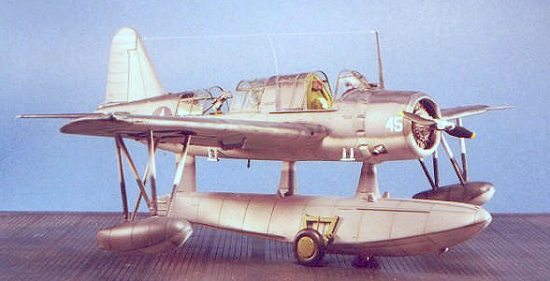 I was going to use the
Yellowhammer sheet for the Kingfisher. I was already suspicious of the sheet,
however, since the camouflage schemes shown did not match photographs of the
particular airplanes the markings were for. My suspicion was confirmed when I
put a wing national insignia on - the decal was at least 15 percent too big!!
The same was true for the fuselage insignias, in comparison with photographs.
Fortunately, I had a SuperScale sheet of generic U.S. WW2 national insignia, and
was able to find stars-and-bars in the proper size, which went on easily. I did
use the type designator and serial number decals from the Yellowhammer sheet. I
got the white numbers from another old SuperScale numbers sheet in the decal
dungeon. The airplane I did is an otherwise-anonymous Kingfisher seen in an
Edward Steichen photograph in flight over Truk Lagoon in 1944. It could have
been Burns' airplane, for which there are no photos that show individual
numbers.
I was going to use the
Yellowhammer sheet for the Kingfisher. I was already suspicious of the sheet,
however, since the camouflage schemes shown did not match photographs of the
particular airplanes the markings were for. My suspicion was confirmed when I
put a wing national insignia on - the decal was at least 15 percent too big!!
The same was true for the fuselage insignias, in comparison with photographs.
Fortunately, I had a SuperScale sheet of generic U.S. WW2 national insignia, and
was able to find stars-and-bars in the proper size, which went on easily. I did
use the type designator and serial number decals from the Yellowhammer sheet. I
got the white numbers from another old SuperScale numbers sheet in the decal
dungeon. The airplane I did is an otherwise-anonymous Kingfisher seen in an
Edward Steichen photograph in flight over Truk Lagoon in 1944. It could have
been Burns' airplane, for which there are no photos that show individual
numbers.
Final Assembly:
I didn't do much weathering, since these airplanes were carried aboard battleships and cruisers, the "old navy" where "if it moves you salute it, and if it doesn't you paint it." In the environment they were in, the paint would have been kept up for corrosion control. I gave the model several coats of Dullcote to give it the flat finish it would have had in the hot tropic sun after being at sea a few months.
I cut open the Falcon canopy, which had been Futured and painted, and assembled it in the open position, with the center section of the gunner's cockpit slid forward under the forward section, with the pilot's canopy slid back.
|
CONCLUSIONS |

Is all that aftermarket worth it? The result of all this is that the "cloth coat" Monogram kit is transformed into a "mink stole" which looks at least as good as the modern Accurate Miniatures Avenger and Dauntless, the Tamiya Wildcat and Corsair, and the Hasegawa Hellcat. The Kingfisher may not have been as well-known or "glamorous" as these other types, but its service was no less meritorious. I think the result is one of the best-looking models in my U.S. Navy collection.
Thanks to Meteor Productions for the review sets.Review kit
IIf you want to see an older review of an out of the box version of this kit, go here.
Copyright Modeling Madness.com
If you would like your product reviewed fairly and fairly quickly, please contact the editor or see other details in the Note to Contributors.
Back to Reviews Page 2016